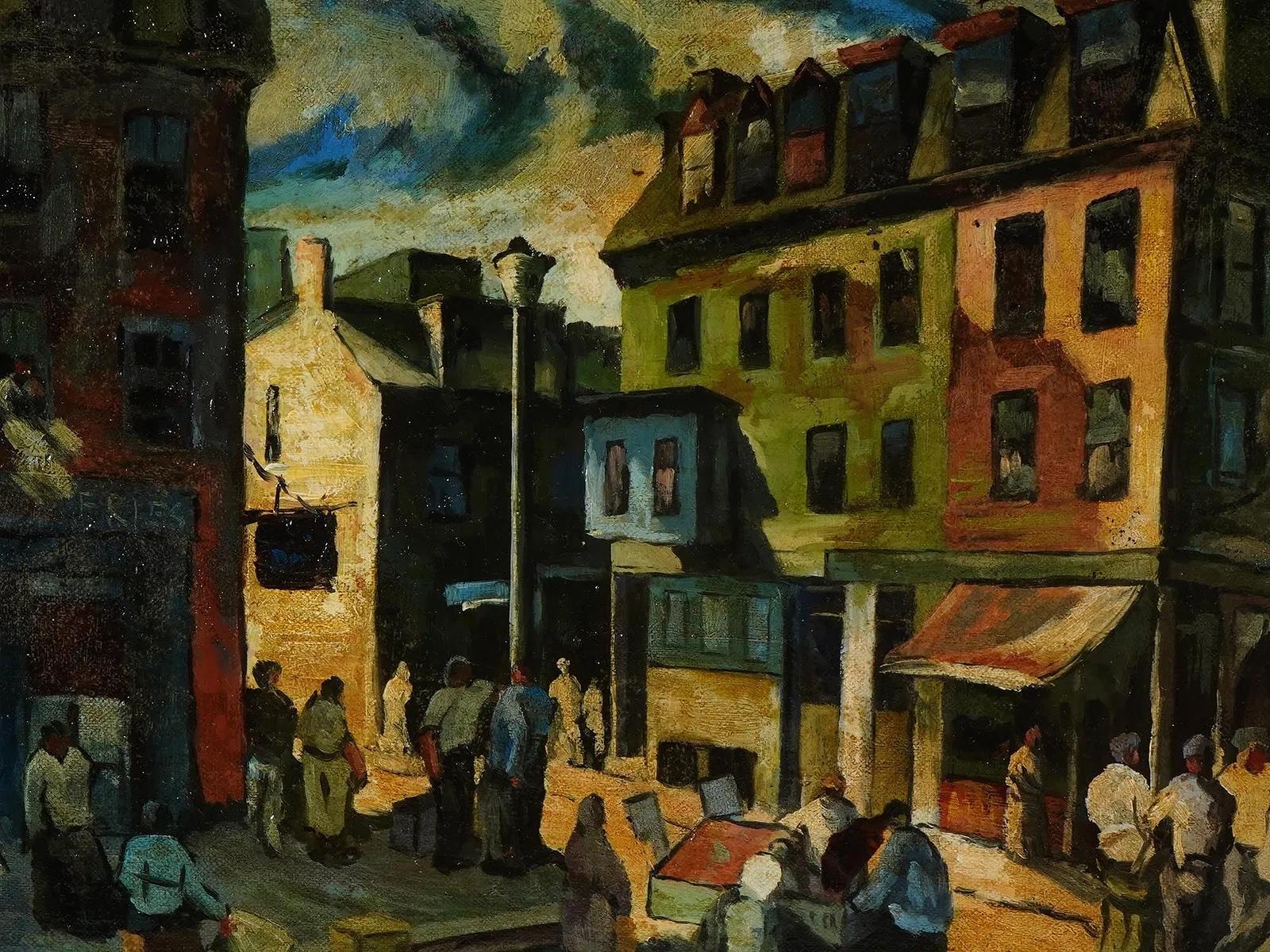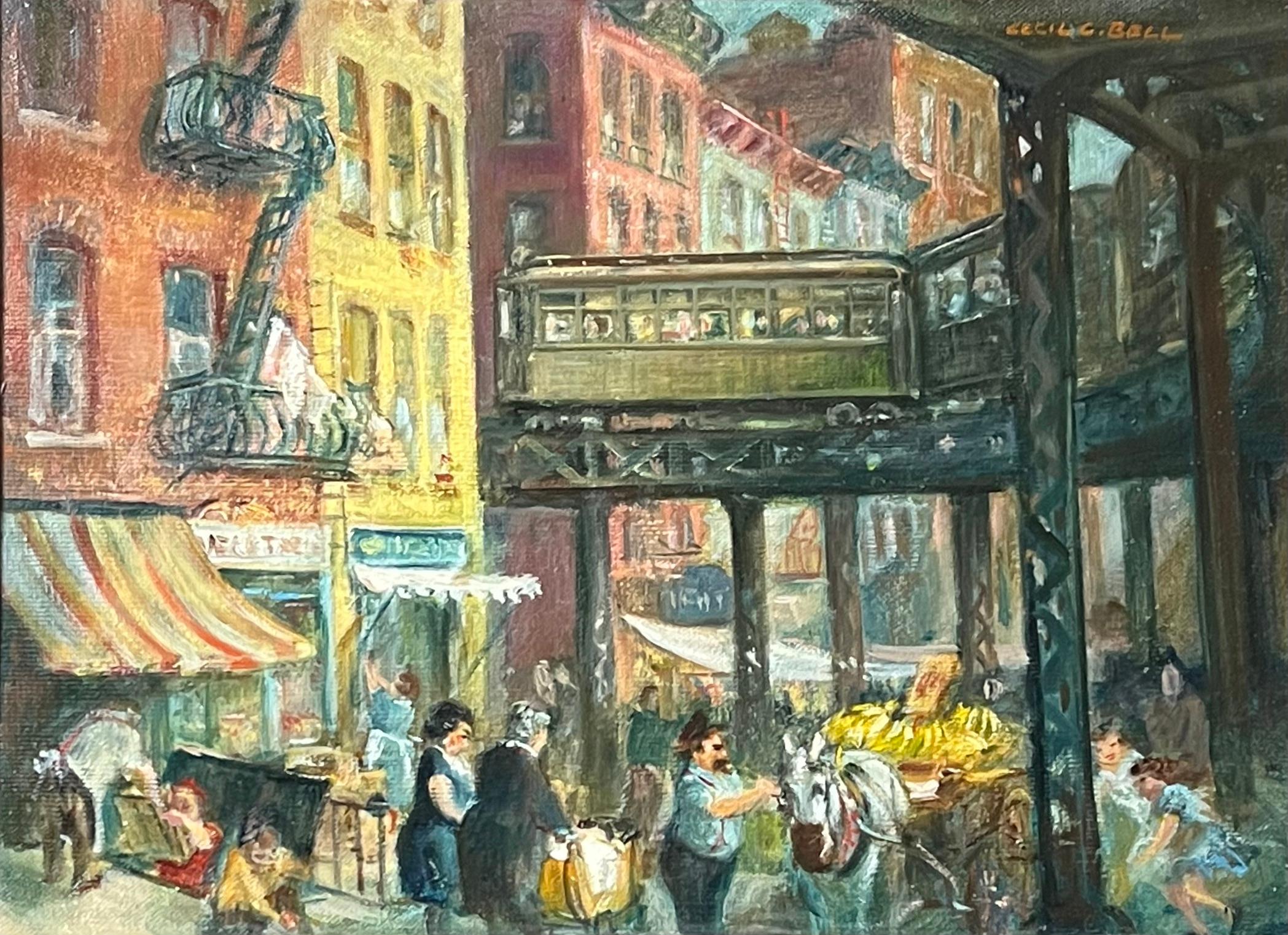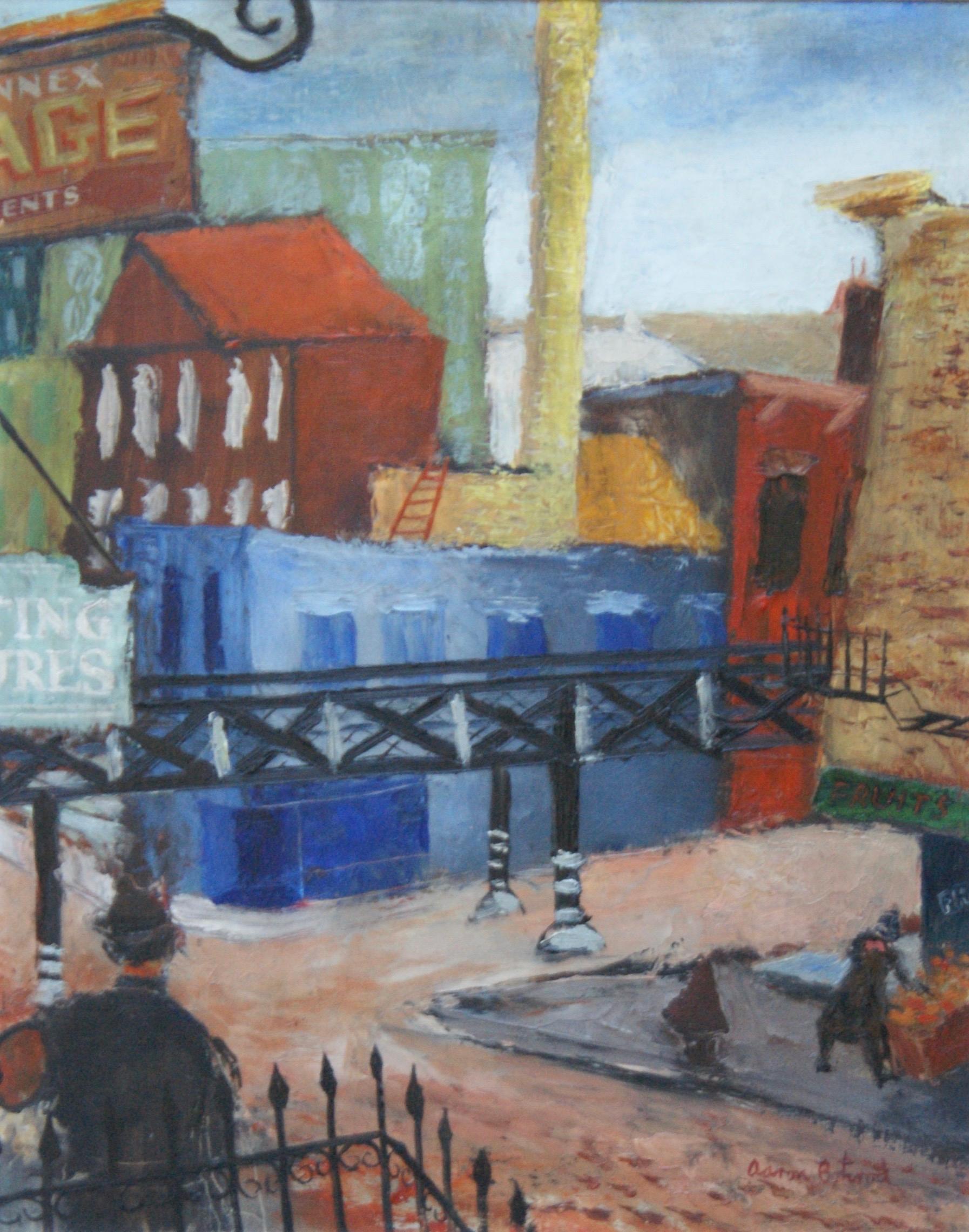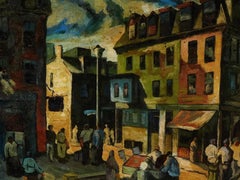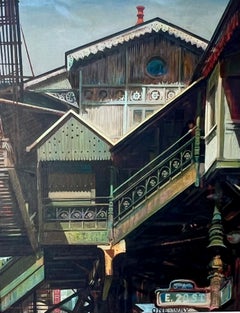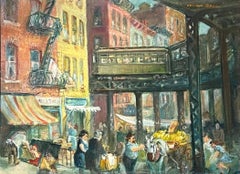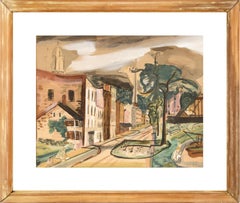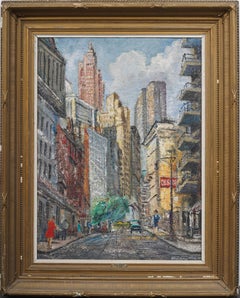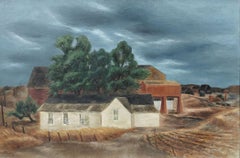Items Similar to Till the Clouds Roll By 1945 Frank Sinatra Mid Century Modern Hollywood Film WPA
Want more images or videos?
Request additional images or videos from the seller
1 of 10
Richard WhorfTill the Clouds Roll By 1945 Frank Sinatra Mid Century Modern Hollywood Film WPA1945
1945
$75,000
£56,968.63
€65,647.17
CA$105,618.58
A$117,093.81
CHF 61,537.37
MX$1,433,036.17
NOK 768,539.12
SEK 721,350.86
DKK 490,015.40
About the Item
Till the Clouds Roll By 1945 Frank Sinatra Mid Century Modern Hollywood Film WPA
TILL THE COULDS ROLL BY (Film Set), oil on canvas, 20 x 24 inches signed “Richard Whorf” lower right and signed and dated on the verso “R. Whorf/ Dec. 21, 1945. Frame by Hendenryk.
ABOUT THE PAINTING
This painting is from the collection of Barbara and Frank Sinatra, dated December 21, 1945 (just nine days after Frank Sinatra’s 30th birthday), and depicts the Metro-Goldwyn-Mayer Culver City backlot during the filming of Till the Clouds Roll By, the direction of the film having been taking over by Richard Whorf in December 1945. It is not presently clear if Whorf gave the Sinatras this painting as a gift, as the presence of the Dalzell Hatfield Galleries label on the verso indicates the painting may have been sourced there. Frank and Nancy Sinatra acquired a number of works from Dalzell Hatfield Galleries during the 1940’s, or perhaps they framed it for the couple.
Sinatra performed “Old Man River’ in the film. Sinatra and June Allyson are depicted in the center of the painting.
PROVENANCE From the Estate of Mrs. Nancy Sinatra; Dalzell Hatfield Galleries, Ambassador Hotel, Los Angeles.
An image of the Dalzell Hatfield label and the back of the original frame (which we replaced with a stunning Heydenrk frame) are attached.
Nancy Sinatra was Fran's first wife. Nancy Rose Barbato was 17 years old when she met Frank Sinatra, an 18-year-old singer from Hoboken, on the Jersey Shore in the summer of 1934. They married in 1939 at Our Lady of Sorrows Church in Jersey City where Frank gave Nancy a recording of a song dedicated to her titled "Our Love" as a wedding present. The young newlyweds lived and worked in New Jersey, where Frank worked as an unknown singing waiter and master of ceremonies at the Rustic Cabin while Nancy worked as a secretary at the American Type Founders.
His musical career took off after singing with big band leaders Harry James and Tommy Dorsey, and Nancy went on tour with Frank and his band which she recalled were the happiest times of their married life. Frank and Nancy Sinatra were the proud parents of three children: Nancy Jr. (born in 1940), Frank Jr. (born in 1944) and Christina (born in 1948). In 1951, Nancy and Frank’s marriage ended in divorce, but the couple remained friends throughout their lives until Frank’s death in 1998 at the age of 82.
Mrs. Sinatra devoted her life to her family, friends and philanthropic causes and died at the age of 101 on July 13, 2018. “In Nancy, I found beauty, warmth and understanding; being with her was my only escape from what seemed to be a grim world,” Frank Sinatra said in a 1952 interview.
BIO
Richard Whorf (June 4, 1906 December 14, 1966) was an American actor, film producer and director, and visual artist. He started his acting career at an early age in Boston, MA and was performing on Broadway by the age of 21. In the 1930s he moved to Hollywood where he became a contract player. He began directing in 1944 with his first film Blonde Fever starring Philip Dorn and Mary Astor. In 1946 and 1947 two films were released in which he directed Frank Sinatra: Till the Clouds Roll By (1946) featuring Sinatra performing “Old Man River” and the musical comedy It Happened in Brooklyn (1947) starring Sinatra in the lead role.
During the 1950s and 60s, Whorf directed multiple television shows including Gunsmoke, My Three Sons, and 67 episodes of The Beverly Hillbillies. He appeared on screen during that time as well, most notably in an episode of The Rifleman as The Illustrator, a painter with a drinking problem. In addition to his involvement in the entertainment industry, Whorf was an artist, having sold his first painting for $100 at the age of 15. Whorf’s artistic endeavors were profiled and his studio photographed for the March 17, 1963 issue of the syndicated newspaper magazine TV Channels. In the article, Whorf is quoted by the reporter, “Who says that a man has to do one thing?”
- Creator:Richard Whorf (1906 - 1966)
- Creation Year:1945
- Dimensions:Height: 31 in (78.74 cm)Width: 27 in (68.58 cm)Depth: 2 in (5.08 cm)
- Medium:
- Movement & Style:
- Period:
- Condition:
- Gallery Location:New York, NY
- Reference Number:1stDibs: LU1156210033462
About the Seller
5.0
Gold Seller
Premium sellers maintaining a 4.3+ rating and 24-hour response times
Established in 2008
1stDibs seller since 2019
195 sales on 1stDibs
Typical response time: <1 hour
- ShippingRetrieving quote...Shipping from: New York, NY
- Return Policy
Authenticity Guarantee
In the unlikely event there’s an issue with an item’s authenticity, contact us within 1 year for a full refund. DetailsMoney-Back Guarantee
If your item is not as described, is damaged in transit, or does not arrive, contact us within 7 days for a full refund. Details24-Hour Cancellation
You have a 24-hour grace period in which to reconsider your purchase, with no questions asked.Vetted Professional Sellers
Our world-class sellers must adhere to strict standards for service and quality, maintaining the integrity of our listings.Price-Match Guarantee
If you find that a seller listed the same item for a lower price elsewhere, we’ll match it.Trusted Global Delivery
Our best-in-class carrier network provides specialized shipping options worldwide, including custom delivery.More From This Seller
View AllCityscape Mid-20th Century Modern Social Realism American Scene Regionalism WPA
Located in New York, NY
Cityscape Mid-20th Century Modern Social Realism American Scene Regionalism WPA
Samuel Thal (1903 to 1964)
"Cityscene"
12 x 16 inches
Oil on board, c. 1940s
Signed verso
Framed: 19...
Category
1940s American Modern Figurative Paintings
Materials
Board, Oil
"Time Remembered" Mid 20th Century NYC Modern American Scene WPA El Railway 1940
Located in New York, NY
"Time Remembered" Mid 20th Century NYC Modern American Scene WPA El Railway 1940
A view of the Third Avenue El (elevated railway) at 28th Street, New York. Signed lower left. Titled verso. c. 1940. oil on board c. 1940, 27.875 h × 21.75 w inches.
BIO
Staats Cotsworth...
Category
1940s American Realist Landscape Paintings
Materials
Oil, Board
NYC EL American Scene Social Realism Mid 20th Century Modern WPA Era Figurative
By Cecil Crosley Bell
Located in New York, NY
NYC EL American Scene Social Realism Mid 20th Century Modern WPA Era Figurative
Cecil Bell (1906 – 1970)
Street Life Under the EL
22 x 30 inches
Oil on canvas, c. 1930s
Signed upper...
Category
1930s American Realist Landscape Paintings
Materials
Canvas, Oil
"Industrial Cityscape, Chicago" WPA Modernism Mid-Century Cityscape 20th Century
By Aaron Bohrod
Located in New York, NY
"Industrial Cityscape, Chicago" WPA Modernism Mid-Century Cityscape 20th Century
Aaron Bohrod (American 1907 – 1992)
Industrial Cityscape
20 x 16 inches
Oil on board
Signed lower ri...
Category
1930s American Modern Landscape Paintings
Materials
Oil, Board
NYC Cityscape American Scene WPA Modern Realism Mid 20th Century Architectural
By Ernest Fiene
Located in New York, NY
NYC Cityscape American Scene WPA Modern Realism Mid 20th Century Architectural
Ernest Fiene (1894-1965)
Cityscape
36 x 30 inches
Oil on canvas
Signed and dated 1930. lower right
Provenance
Estate of the artist.
ACA Galleries, New York
Exhibited
New York, Frank Rehn Gallery, Changing Old New York, 1931.
New York, ACA Galleries, Ernest Fiene: Art of the City, 1925-1955, May 2-23, 1981, n.p., no. 5.
BIO
Ernest Fiene was born in Elberfeld, Germany in 1894. As a teenager, Fiene immigrated to the United States in 1912. He studied art at the National Academy of Design in New York City from 1914 to 1918, taking day classes with Thomas Maynard and evening classes with Leon Kroll. Fiene continued his studies at the Beaux-Arts Institute of Design in New York from 1916 to 1918, adding classes in printmaking at the Art Students League in 1923.
Fiene began his career as an artist in 1919 with his first exhibition of watercolors at the MacDowell Club arranged by his mentor Robert Henri. In 1923 the Whitney Studio Club mounted a large exhibition of his works. The following year he had an exhibition at the New Gallery in New York, which completely sold out all fifty-two works, including paintings, watercolors, drawings, and etchings. With the proceeds of sales from the New Gallery exhibition, Ernest Fiene and his younger brother Paul, a sculptor, built studios in Woodstock, New York in 1925.
In the early Twenties Ernest Fiene painted mostly landscapes of Woodstock and both the Ramapo and Hudson River Valleys. The first monograph from the Younger Artists Series was published on Fiene in 1922. Published in Woodstock, the series went on to include Alexander Brook, Peggy Bacon, and Yasuo Kuniyoshi. The book reproduced 1 illustration in color and another 27 reproductions in black and white. Around 1925 Fiene became fascinated with the intensity, excitement, and opportunities for color harmonies New York City offered as a subject. His paintings shifted to urban and industrial themes with architecture, industry, and transportation becoming his subjects.
By 1926 Fiene had attracted the dealer Frank K.M. Rehn, who gave him a one-man exhibition that year, which travelled to the Boston Arts Club. C.W. Kraushaar Galleries gave Fiene a one-man exhibition of urban, landscape, portrait, and still life paintings in 1927. Julianna Force, the director of the Whitney Studio Club and first director of the Whitney Museum of American Art, included two of Fiene’s paintings in a fall exhibition in 1928. The Whitney Studio Club showed Fiene’s paintings in a two-man exhibition with Glenn O. Coleman that year and acquired three of Fiene’s paintings. Also in 1928 Fiene became affiliated with Edith Halpert’s Downtown Gallery where he had an exhibition of 20 lithographs in the spring. Fiene sold his house in Woodstock in 1928 to spend more of his time in New York City.
With so many successful exhibitions, Fiene returned to Paris in 1928-29 where he rented Jules Pascin's studio and studied at the Académie de la Grande Chaumière. In France, Fiene painted both landscape and urban subjects developed from ideas influenced by Cubist geometry and the use of flat areas of broad color. Upon returning to New York in 1930, Fiene used this new approach to continue to paint New York skyscraper and waterfront subjects, as well as to begin a series of paintings on changing old New York based on the excavations for Radio City Music Hall and the construction of the Empire State Building. Frank K.M. Rehn Galleries exhibited this series, titled “Changing Old New York,” in 1931. Fiene also has solo exhibitions at Rehn Galleries in 1930 and 1932. Fiene’s oil paintings are exhibited at the Chicago Arts Club in 1930 as well.
Fiene was included in the Museum of Modern Art’s exhibition Painting and Sculpture by Living Americans in December of 1931. Visiting New York, Henri Matisse saw the exhibition and called Fiene’s Razing Buildings, West 49th Street the finest painting he had seen in New York. Fiene had two mural studies from his Mechanical Progress series exhibited at the Museum of Modern Art’s exhibition Murals by American Painters and Photographers in 1932. Fiene sent View from my Window which depicts Fiene working on a lithograph stone while looking out his window to the newly completed Empire State Building to the Carnegie International in 1931. In 1932 Fiene participated in the first Biennial of American Painting at the Whitney Museum and his prints were included in exhibitions at the Downtown Gallery and the Wehye Gallery. In the same year, Fiene was awarded a Guggenheim fellowship to further study mural painting in Florence, Italy.
On his return from Italy in 1933 Fiene re-engaged himself in New York City life and won several public and private mural projects. Fiene resumed his active exhibition schedule, participating in two group exhibitions at the Whitney Museum and a one-man exhibition of recent paintings at the Downtown Gallery in January 1934. In 1933 he purchased a farm in Southbury, Connecticut, which added Connecticut scenes to his landscape subjects. This was also the year Fiene began to spend summers on Monhegan Island, Maine, where he painted seascapes, harbor scenes, and still lifes.
Fiene’s landscape paintings attracted numerous commissions as part of the American Scene movement. Through the fall and winter of 1935-36, Fiene took an extended sketching trip through the urban, industrial, and farming areas of Pennsylvania and West Virginia. Most of the twenty-four Pennsylvania urban and rural paintings...
Category
1930s American Modern Landscape Paintings
Materials
Canvas, Oil
Greenwich Village NYC WPA Mid 20th Century American Scene Ashcan Modern Realism
Located in New York, NY
Greenwich Village NYC WPA Mid 20th Century American Scene Ashcan Modern Realism
Alfred Mira (1900-1981)
Greenwich Village NYC
14 x 17 inches
Oil on board,...
Category
1930s American Realist Landscape Drawings and Watercolors
Materials
Oil, Board
You May Also Like
"To Market To Market", Early 20th Century Figurative Brooklyn Cityscape
Located in Soquel, CA
"To Market To Market", a whimsical early 20th century modern figurative village landscape by Frank Simon Herrmann (American, 1866-1942). In this charming scene of a downtown village ...
Category
Early 20th Century Modern Landscape Drawings and Watercolors
Materials
Paper, Gouache
Moonlight Shanties
Located in Los Angeles, CA
Moonlight Shanties, c. 1940s, oil on canvas, 24 x 18 inches, signed lower right, signed and titled verso
About the Painting
In Moonlight Shanties, Joachim depicts a lower-class neighborhood sitting along-side an elevated road or railway which crowds out the small nearby houses and structures. Joachim’s use of an expressionist palette and gestural brushstrokes together with the isolated figures obscured in the shadows, create a feeling of unease, isolation and even loneliness. From the 1920s through 1940s, American artists commonly employed expressionist conventions in their social realist works which portrayed the gritty side of urban America, especially the communities of the city-dwelling poor. Expressionist styles were considered appropriate for bridging the gap between the modernist idea of art-for-art’s-sake and the narrative qualities demanded by the dual crises of the Great Depression and World War II. Moonlight Shanties successfully uses these expressionist methods to portray a neighborhood and its people who appear to be literally and figuratively “on the edge.”
About the Artist
Paul Lamar Joachim...
Category
1940s American Modern Landscape Paintings
Materials
Oil
Antique American Modernist Large New York Cityscape Framed Street Scene Painting
Located in Buffalo, NY
Antique American modernist street scene painting. Oil on canvas. Signed. In excellent original condition. Handsomely framed in a late 19th century fluted cove giltwood molding. E...
Category
1940s Modern Landscape Paintings
Materials
Canvas, Oil
"Glasco Landscape" Albert Heckman, circa 1940 New York Modernist Landscape
By Albert Heckman
Located in New York, NY
Albert Heckman
Glasco Landscape, circa 1940
Signed lower right
Oil on canvas
25 1/4 x 39 1/2 inches
Albert Heckman was born in Meadville, Western Pennsylvania, 1893. He went to New York City to try his hand at the art world in 1915 after graduating from high school and landing a job at the Meadville Post Office. In 1917, at the age of 24, Heckman enrolled part-time in Teachers' College, Columbia University's Fine Arts Department to begin his formal art education. He worked as a freelance ceramic and textile designer and occasionally as a lecturer at the Metropolitan Museum of Art. In the early 1920s, at the age of almost 30, he graduated with a Bachelor of Arts degree from Columbia Teachers College. He was especially impacted by his instructor at Columbia, Arthur Wesley Dow.
After graduating, he was hired by the Teachers' College as a Fine Arts instructor. He stayed with Columbia Teachers' College until 1929, when he left to attend the Leipzig Institute of Graphic Arts in Leipzig, Germany. Isami Doi (1903-1965), who was born in Hawaii, was arguably his most impressive student at Columbia. Doi is now regarded as one of the most prominent artists hailing from Hawaii. Heckman became an active member and officer of the Keramic Society and Design Guild of New York in the 1920s as part of his early commercial art career. The Society's mission was to share knowledge and showcase textile and ceramic design exhibits.
In 1922, Heckman married Florence Hardman, a concert violinist. Mrs. Heckman's concert schedule during the 1920s kept Albert and Florence Heckman apart for a significant portion of the time, but they spent what little time they had together designing and building their Woodstock, New York, summer house and grounds. A small house and an acre of surrounding land on Overlook Mountain, just behind the village of Woodstock, were purchased by Albert and Florence Heckman at the time of their marriage. Their Woodstock home, with its connections, friendships, and memories, became a central part of their lives over the years, even though they had an apartment in New York City.
Heckman's main artistic focus shifted to the house on Overlook Mountain and the nearby towns and villages, Kingston, Eddyville, and Glasco. After returning from the Leipzig Institute of Graphic Arts in 1930, Mr. Heckman joined Hunter College as an assistant professor of art. He worked there for almost thirty years, retiring in 1956. Throughout his tenure at Hunter, Mr. Heckman and his spouse spent the summers at their Woodstock residence and the winters in New York City. They were regular and well-known guests at the opera and art galleries in New York. Following his retirement in 1956, the Heckmans settled in Woodstock permanently, with occasional trips to Florida or Europe during the fall and winter. Mr. Heckman's close friends and artistic career were always connected to Woodstock or New York City. He joined the Woodstock art group early on and was greatly influenced by artists like Paul and Caroline Rohland, Emil Ganso, Yasuo Kuniyoshi, Andre Ruellan, and her husband, Jack...
Category
1940s American Modern Figurative Paintings
Materials
Canvas, Oil
Oil Painting "Brooklyn" 1940's
Located in Rochester, NY
Mid-Century Modern oil painting, 1940s cityscape, "Bedford at Lafayette, Brooklyn". Oil on masonite. Signed King Rich. In vintage modernist frame...
Category
Mid-20th Century American Mid-Century Modern Paintings
Materials
Paint
Lower Manhattan Cityscape American Artist WPA Era NY School c. 1930 Henry Ensol
Located in Buffalo, NY
An original modern 1930's oil painting by WPA era American artist Henry Ensol. This work comes in a period frame likely original to the piece.
Category
1930s American Modern Landscape Paintings
Materials
Canvas, Oil
More Ways To Browse
Old Hollywood Art
Frank Sinatra
Artist Painting Landscape Wpa
Frank Sinatra Signed
Mary Frank Art
Ambassador Hotel
Photograph Frank Sinatra
Frank Sinatra Paintings
Painting Of Sinatra
R Frank Oil Painting
Vintage Entertainment Center
1940s Cabin
Wpa Photographs
Lady Barbara
Waiter Painting
Mary Rose Young
Dior Blonde
Television Philips Vintage
